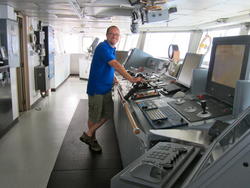What Goes on… on the Bridge?

The Bridge must be manned by at least two bodies on each watch. A standard watch is four hours long and consists of either the Captain or a Mate and an AB. The Officer of the Watch (OOW) maneuvers the ship while the AB does a walkthrough of the entire ship. The walkthrough is thorough and consists of all the different compartments on the ship as well as any open areas. ABs are looking for anything out of the ordinary such as equipment that is out of place, distressed persons, objects falling down, smoke, and suspicious smells or activity.
The two main jobs for the Bridge during a typical watch on a research cruise are the safe navigation of the vessel and facilitating science. The officer maneuvers the ship, plots position on charts, and monitors radars and GPS. The AB acts as a lookout for possible dangers to the ship such as land, other ships, pirates, and reefs. The Captain’s main concern is to make sure the crew and scientists are working in a safe environment. Since the Bridge keeps an eye on the entire ship, there also needs to be a special safety precaution that looks after the Bridge itself and its crew. The “Dead Man Alarm” is a motion-activated sensor that detects the location of the Officer of the Watch every twelve minutes. If something unforeseen were to happen on the Bridge, the alarm would warn others. This alarm can be reset manually with the push of a button or one can walk past the sensors to reset it for another twelve minutes.
The main objective of our current cruise is to successfully map and dredge seamounts in the Tuvalu, Samoa, and Tonga region. The Roger Revelle is excellent for dredging due to its capability of dynamic positioning. According to Captain Wes Hill, in the old days the dredging method was to throw a bucket over and hope it would come up full. Current technology allows the Bridge crew to input the desired speed of the ship and coordinates along the dredging track into a computer, after which GPS satellite signals tell the ship exactly where to go. The computer will switch to autopilot and remain on course without interference. It can do so because the ship is equipped with three thrusters (one at the bow and two at the aft) that move independently of each other and can spin 360˚! With the help of the thrusters changes in wind and current can be adapted to and the ship can be held within a few meters of a selected geographic point.
The Bridge crew and science team work together to have a successful cruise and meet the science objectives. Without the Bridge (and dynamic positioning) we would still be throwing buckets over and praying to King Neptune and his royal sea court for dredges full of rocks from the deep seafloor.
By Jacqueline Engel
- 8532 reads
